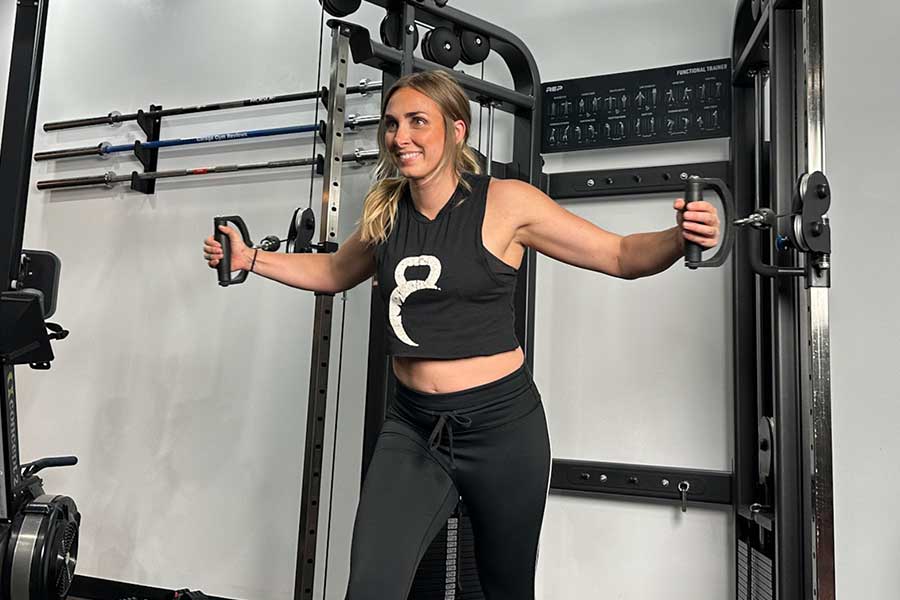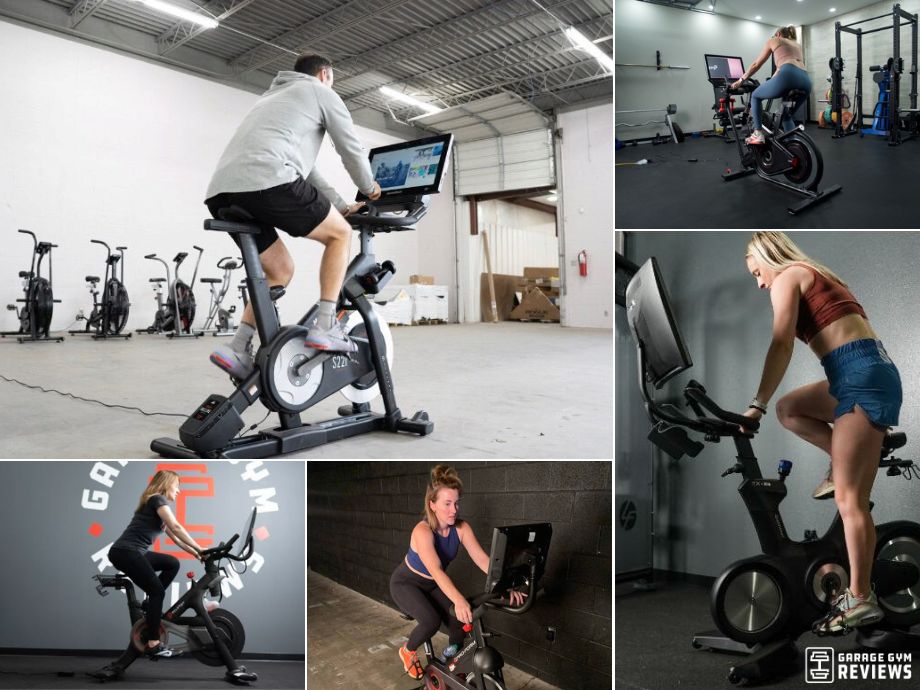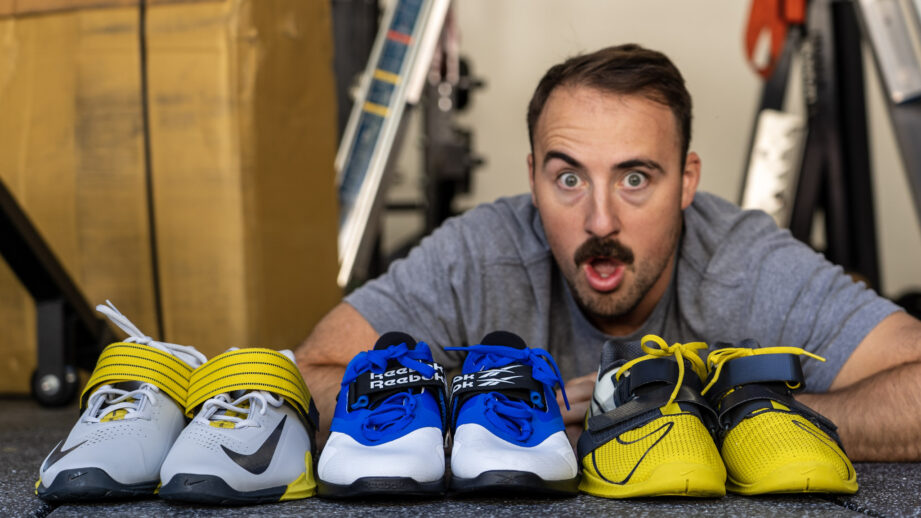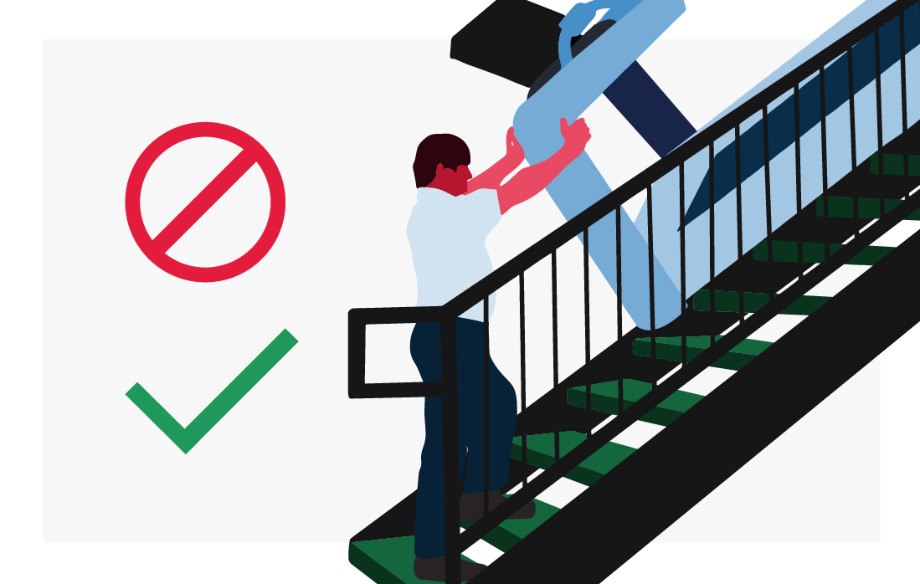If you still believe that the barbell bench press is the only way to build a big chest, it’s about time you got out of the 1970s and realized things have moved on from there.
Wait a moment before you judge me. I’m a huge fan of compound movements for the chest (like bench presses and dumbbell presses). But, they’re not the only way to build strength and muscle. You can activate your chest muscles in other ways too—for example, using cables.
Cables are safe and versatile, and may provide more muscle activation compared to free weights because your pecs are constantly under tension. You can still do compound movements and add cable exercises to your workout routine, or alternatively, you can do a full cable chest workout if that’s what you’d prefer.
RELATED: Best Cable Machine for Home Gyms
Today, I’ll cover the benefits of a cable chest workout, a step-by-step guide on how to do my 12 favorite cable chest exercises, and finish off with three cable chest workouts aimed at different fitness levels.
Ready to build an Arnold-esque chest with cables only? Then let’s begin.
Medical disclaimer: This article is intended for educational and informational purposes only. It is not intended as a substitute for medical advice. For health advice, contact a licensed healthcare provider.
Why Do a Cable Chest Workout?
There are tons of reasons why someone would want to do a cable chest workout. Here are a few of the most important:
Versatility
The pulleys on a cable machine can be set at a high, medium, or low position (or technically, anywhere in between). You can stand, kneel, sit, or lie down on a bench. This means you have an endless number of exercises you can perform, all of which target the chest muscles slightly differently. This keeps your chest workouts exciting and makes them highly versatile.
Safety
Using cables is safer than exercising with free weights such as barbells or dumbbells. They’re a great option for beginners or anyone who’s had an injury that limits their mobility. Even for those who have been using free weights for a while, you still have that slight doubt when lifting a heavy weight. The risk of getting injured close to disappears when using a crossover machine.
At the same time, the increase in muscle mass and strength1 you can get from free weights and machines are similar.
Muscle Activation
Because of the way cables are designed, there is constant tension on your chest muscles during cable chest exercises. With dumbbells and barbells, the top and bottom of the movement usually provide less resistance, whereas this does not hold true with cables. Unlike fixed resistance machines, cable machines allow a considerably greater number of degrees of freedom and require considerably greater activation of the core muscles2.
Adjustability
It takes a split second to adjust the weight on a cable machine to make it easier or more difficult to do, making progression or regression simple. You can adjust your body position (for example, by leaning forward slightly) to completely change an exercise. Most exercises can be performed one arm at a time or with a slower tempo, highlighting the benefits of using cables.
The 12 Best Cable Chest Exercises
Now that you know the benefits of doing a cable chest workout, here are my 12 best cable chest exercises for you to try:
Standing Cable Chest Press
Why Do It: Standing cable chest presses work the pectoralis major, deltoids, serratus anterior, core, and triceps brachii. This exercise is friendlier on the shoulder joints compared to the barbell bench press, but works similar muscle groups. You can adjust the height of your press to activate different parts of your chest, and it requires core strength and engages your stabilizer muscles because you stand during the movement.
How to Do It:
- Attach handles to each side of the cable machine and set the pulleys so they’re between chest and shoulder height.
- Select the desired weight and take hold of the handles.
- Step forward a couple of steps and put one foot in front of the other so that you’re in a staggered stance.
- Stick your chest up, look straight ahead, and tense your core and glutes. At the same time, position your hands so they’re outside of your chest on either side of the body at a 90-degree angle.
- Press through by extending your arms so they’re straight out in front of you and the handles meet in the middle.
- Pause, then slowly return to the original position.
- Continue for the desired number of repetitions.
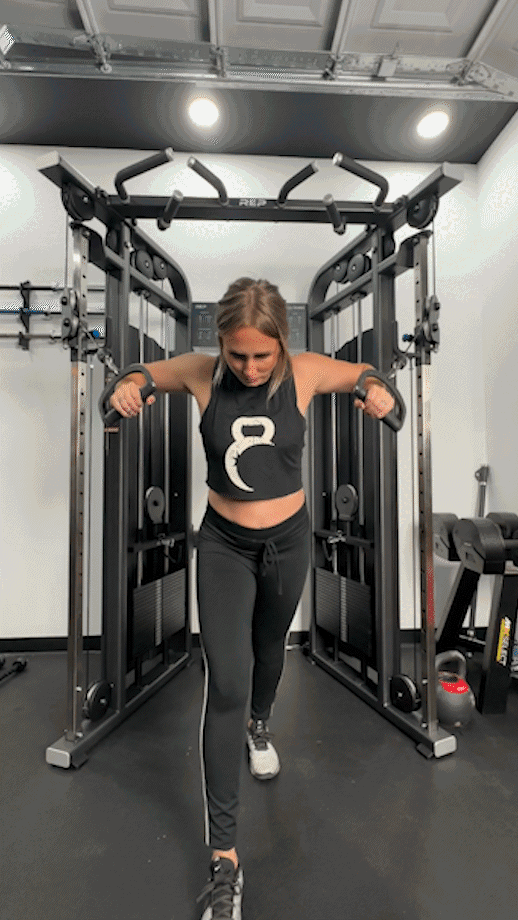
Cable Crossover
Why Do It: With a cable crossover, you get the benefit of a cable fly (which you’ll see below), but with an added benefit due to the full range of motion. You’ll work multiple muscles in your upper body, but mainly your pecs and front delts.
How to Do It:
- Set the cable crossover machine so both sides are in the highest position and attach handles.
- Stand in the middle and grab the handles. Step forward slightly but keep your arms wide so you feel a stretch in your chest muscles.
- Engage your core and keep your head neutral. This is your starting position.
- Push both hands inward toward each other, activating your pecs. When the handles get close to each other, continue extending until one arm crosses over the other.
- Hold for a moment, then slowly return your arms to the stretched position.
- Repeat for reps.
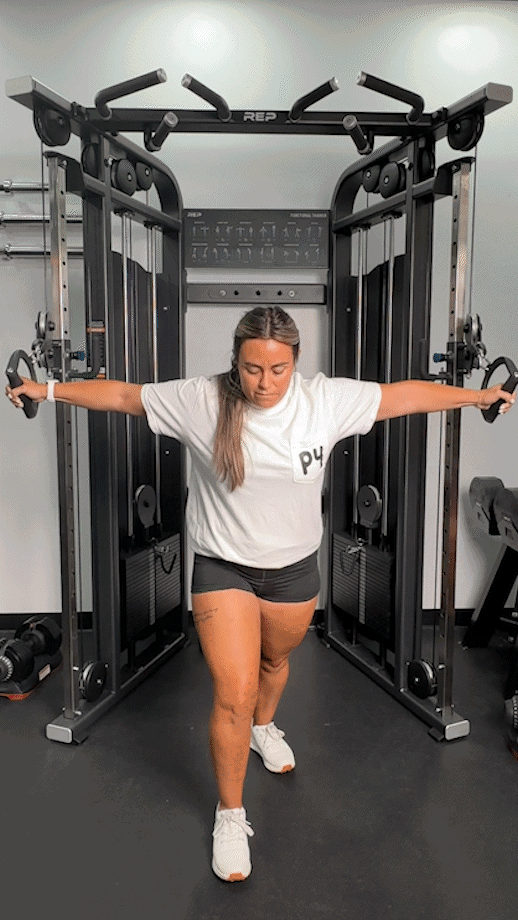
Cable Bench Press
Why Do It: A chest day wouldn’t be complete without a bench press, right? Well, kind of. A modified version of the dumbbell bench press, cable bench presses work similar muscle groups including the chest, delts, triceps, and core. It’s an extremely safe exercise to do because you’re using cables and a flat bench.
RELATED: Best Weight Bench
How to Do It:
- Get a flat bench and place it at the center of the cable machine.
- Attach handles to each side of the machine and set the cable pulleys so they’re in the lowest position. Pick the correct weight too.
- Lie down on the bench and take hold of the handles. Your feet should be flat on the floor and your hands in an overhand grip (with your palms facing away from you as you would do a dumbbell bench press).
- Retract your shoulder blades, tense your core, and then press the cables up until your arms are straight above your body.
- Squeeze, then lower the handles back down.
- Repeat.
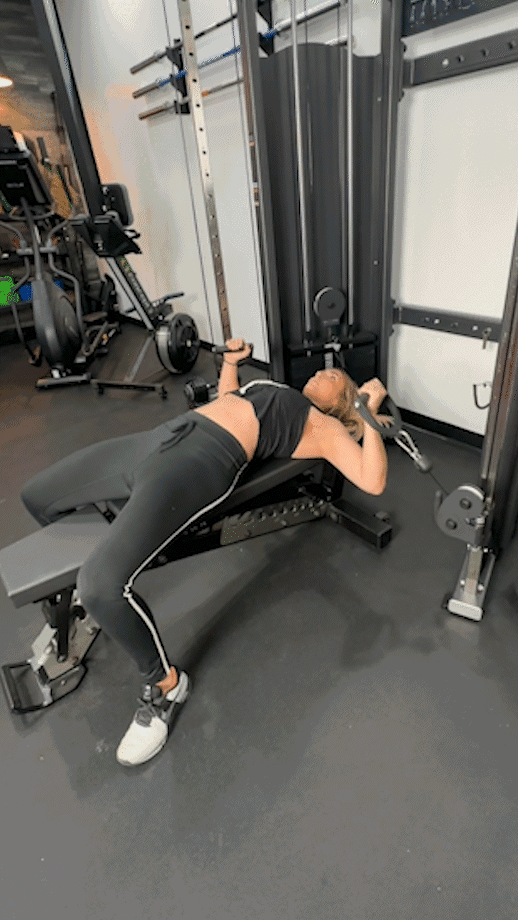
Cable Incline Bench Press
Why Do It: Cable incline bench presses are similar to the cable bench press (which you saw above) but with an incline bench instead of a flat one. This places more emphasis on your upper chest muscles.
How to Do It:
- Set a bench at a 30- to 45-degree angle, and then position it in the middle of the cable machine.
- Attach handles to both sides and adjust the pulleys so they’re in the bottom position.
- Lie down with your feet flat on the floor and grab the handles. Move your hands so that they’re outside of your chest on either side of your body.
- Engage your core and then push the handles up until your arms are extended and the handles meet in the middle. Focus on activating your upper chest here.
- Pause, then lower the handles until they’re back to the starting position.
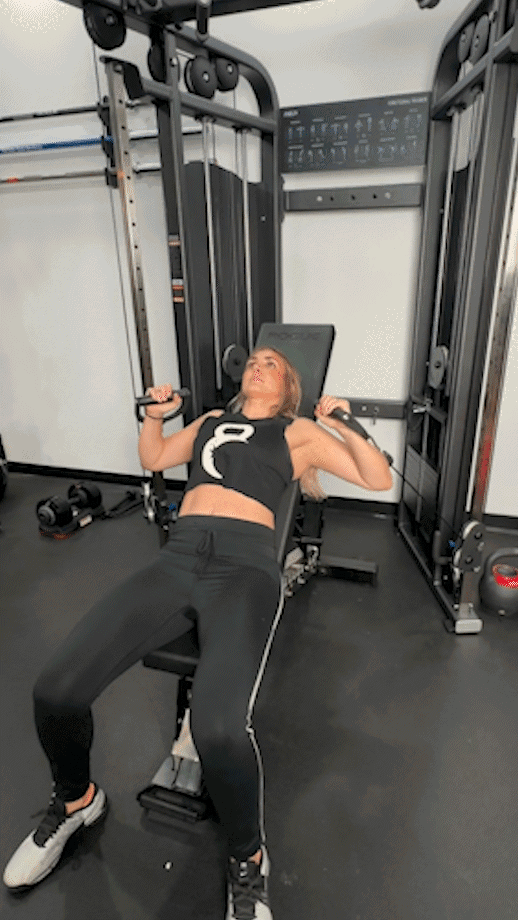
Cable Fly (Middle Chest)
Why Do It: The cable chest fly is one you probably know already. It’s simple to learn but comes with tons of benefits, including constant tension on your pecs and front delts to maximize muscle growth. It’s a similar exercise to the dumbbell fly but a lot friendlier on the shoulder joints, so a great exercise for those who have injuries or limited mobility.
How to Do It:
- Adjust the cable machine so it’s at chest height and put handle attachments on both sides.
- Take hold of the handles but keep your arms wide.
- Step forward slightly until you feel a stretch in your chest and delts (your feet can either be next to each other or in a split stance).
- Engage your core, keep your head neutral, and ensure that you have a slight bend in your elbows.
- Pull the handles until your arms meet in the center of your chest in front of your body.
- Pause, then return the handles to the stretched position in a controlled manner.
- Repeat for the desired number of reps.
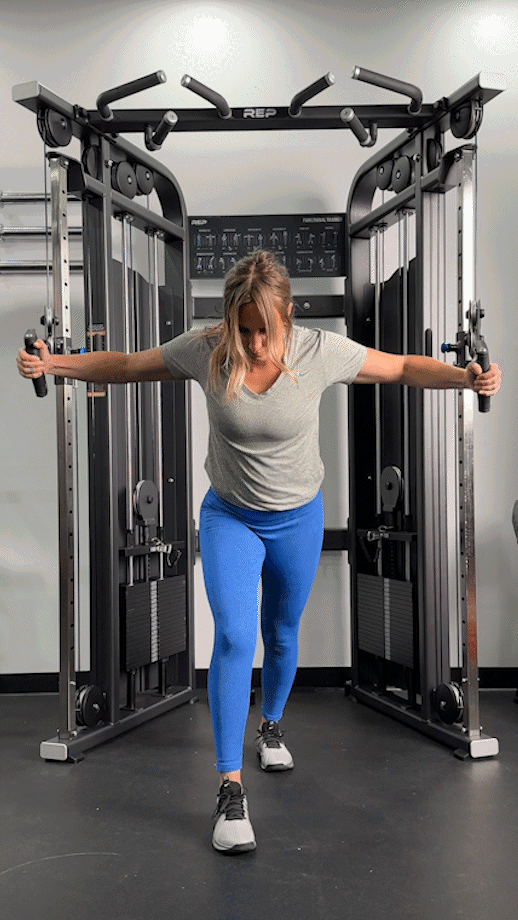
Low Cable Fly
Why Do It: Similar to the cable fly, the low cable fly places slightly more emphasis on the upper pecs. I find that this exercise requires a lot of core strength and stability too because you’re pulling the handles upwards.
How to Do It:
- Place handle attachments on either side of the cable machine and put the pulleys in the lowest position.
- Stand in the middle and grab the handles with an underhand grip. Step forward and adjust your feet so you’re comfortable (you can choose between a normal stance or a split stance with the low cable fly).
- Put your arms down by your side (your hands should be near your hips on either side of your body and your palms should be facing forward).
- Now, pull the handles upward until they meet in the middle of your chest. You’ll need a slight bend in your elbows for this.
- Hold for a second, then slowly return the handles so your hands are by your sides.
- Repeat.
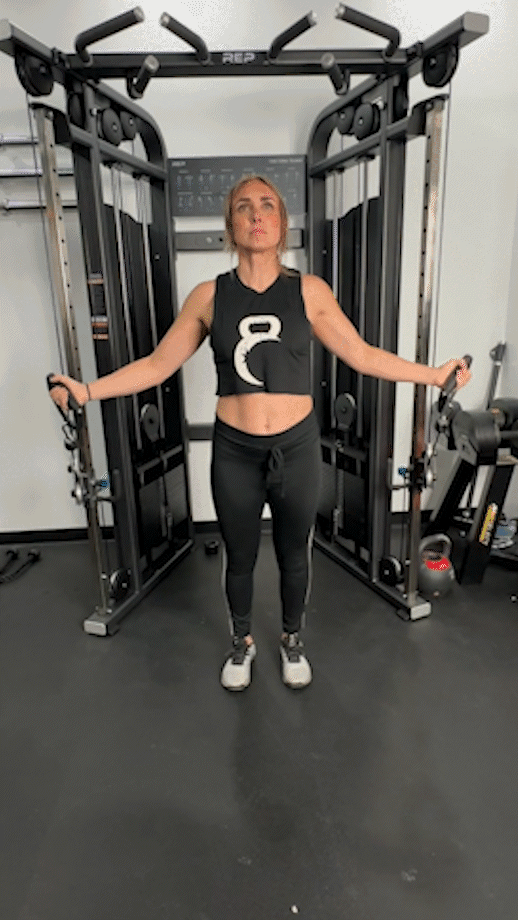
Single-Arm Cable Crossover
Why Do It: Because single-arm cable crossovers are a unilateral exercise, they can help to fix muscular imbalances. You may be able to increase your range of motion because you’re not exercising both arms at the same time, which could mean a deeper chest contraction.
How to Do It:
- Put a single pulley in a high position and attach a handle to it. Select the desired weight.
- Stand sideways to the machine and ensure that your feet are shoulder-width apart and your core is tight.
- Take hold of the handle with your left hand (your left palm should be facing the floor).
- Keeping your head neutral and your chest up, pull the handle down and across your body. The end position should be around your pelvic region slightly in front of your body.
- Pause. Next, return the handle to the high position slowly.
- Continue for repetitions, then do the same with your right hand.
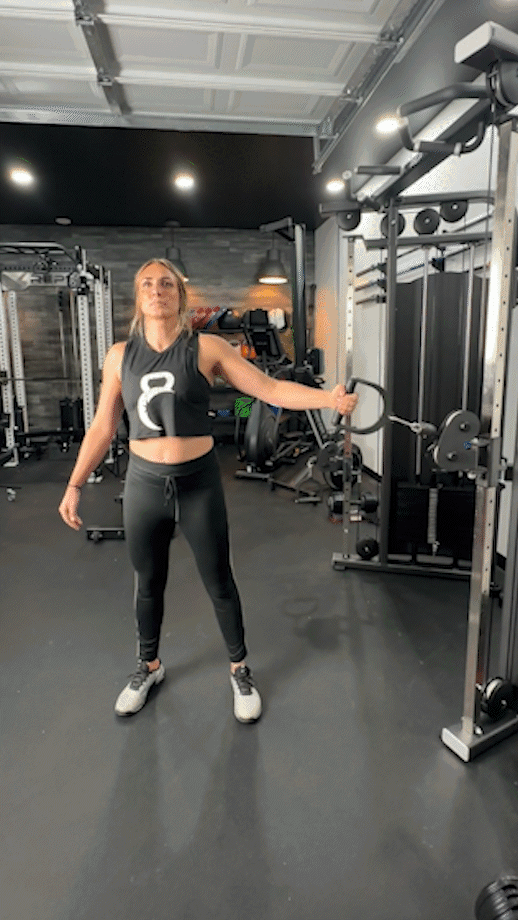
Cable Straight-Arm Pullovers
Why Do It: Cable straight-arm pullovers are a variation of the dumbbell pullover. This exercise works your chest, lats, serratus anterior, core, glutes, triceps, and more. Because of the stretch you get, you may also improve your overhead shoulder mobility. This can help with everyday actions such as placing items on shelves or in kitchen cupboards.
How to Do It:
- Position a flat bench close to one side of a cable machine and put the pulley at the bottom.
- Choose the desired attachment (you can use a rope, a straight bar, or a slightly curved bar for this exercise), and pick the correct weight.
- Lie down on the bench with your head closest to the crossover machine, taking hold of the attachment with an overhand or neutral grip, depending on the attachment you chose. Your arms will be extended behind your head with the elbows bent slightly.
- Pull the attachment upward until your arms are straight and directly above your chest.
- Slowly return the attachment to the original position.
- Keep going for reps.
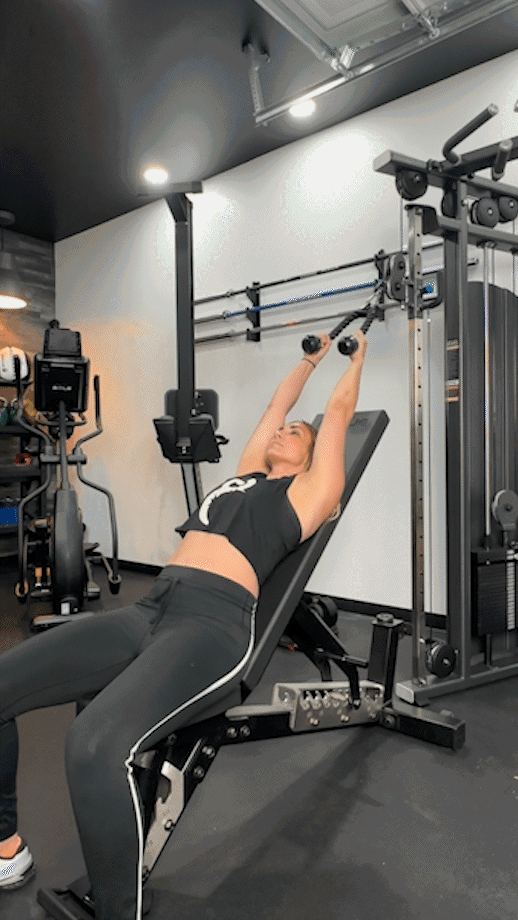
Seated Cable Fly
Why Do It: With a seated cable fly, you work the same muscle groups as the regular cable fly and the cable crossover. The main difference is that you have back support, which means that you may be able to increase the weight. You can easily adjust the exercise by leaning forward slightly, placing more tension on the upper chest.
How to Do It:
- Adjust a bench so it’s in an upright position (similar to how you would do a dumbbell shoulder press) and position it at the center of the cable machine.
- Choose the desired weight and attach handles to both sides. The cables should be at chest height when seated.
- Sit down on the bench and grab the handles, keeping your arms open.
- Retract your shoulder blades and engage your core. This is your starting position.
- With a slight bend in your elbows, move your arms forward so they end up in front of your chest with the handles touching each other.
- Return the handles to the stretched position.
- Continue for the desired number of repetitions.
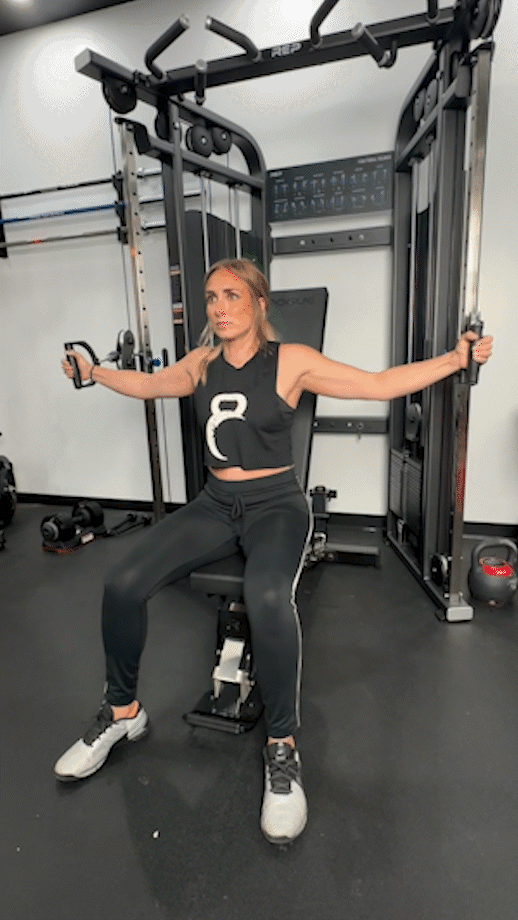
Cable Shoulder Rotation Press
Why Do It: By rotating your shoulders and torso, cable shoulder rotations allow a full range of motion when compared to the standing cable chest press. This activates the chest, delts, core, triceps, and serratus anterior to a higher level. It’s a unilateral exercise, too, which may help to fix muscular imbalances.
How to Do It:
- Set one side of a cable machine to chest height and attach a handle.
- Stand in the middle of the cable crossover and grab the handle with your left hand with an overhand grip (your palm should be facing the floor).
- Step forward with your left foot into a split stance. Your left foot (front foot) should be flat on the floor but your right foot (back foot) should be on its toes.
- Now, position your left hand so that it’s outside of your chest on the left side of your body.
- Straighten your left arm by pressing the handle forward. When the arm is nearly straight, rotate your shoulders and torso, similar to how you would throw a punch. This will allow you to extend your left arm even further.
- Pause, then return to the original position in a controlled manner.
- Continue for reps, then repeat with your right hand.
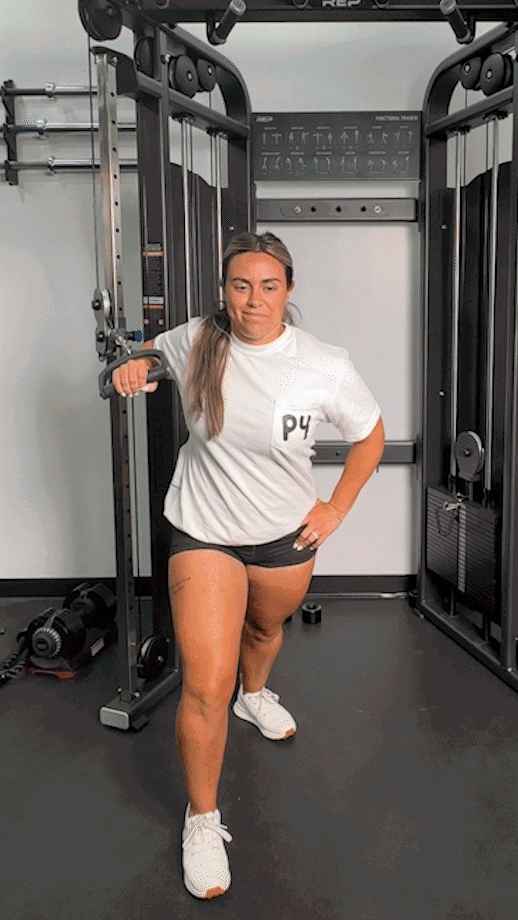
Decline Cable Fly
Why Do It: To target your lower chest, the decline cable fly is a great exercise. The lower chest can sometimes be ignored during chest training, which is why it’s on this list. I like that it’s a lot easier on the shoulder joints compared to a decline dumbbell fly.
How to Do It:
- Set a bench so it’s at a 15- to 30-degree decline angle and place it in the middle of a cable machine.
- Move both pulleys to the lowest position and choose your weight. Attach handles.
- Lie down on the bench, taking hold of the handles with an underhand grip. Your palms should be facing the ceiling and your arms should be wide open, feeling a stretch in the deltoids and chest.
- Retract your shoulder blades, then lift your arms upward and toward each other until the handles meet in the center above your body.
- Slowly lower the handles back down until your arms are in line with your shoulders.
- Repeat for repetitions.
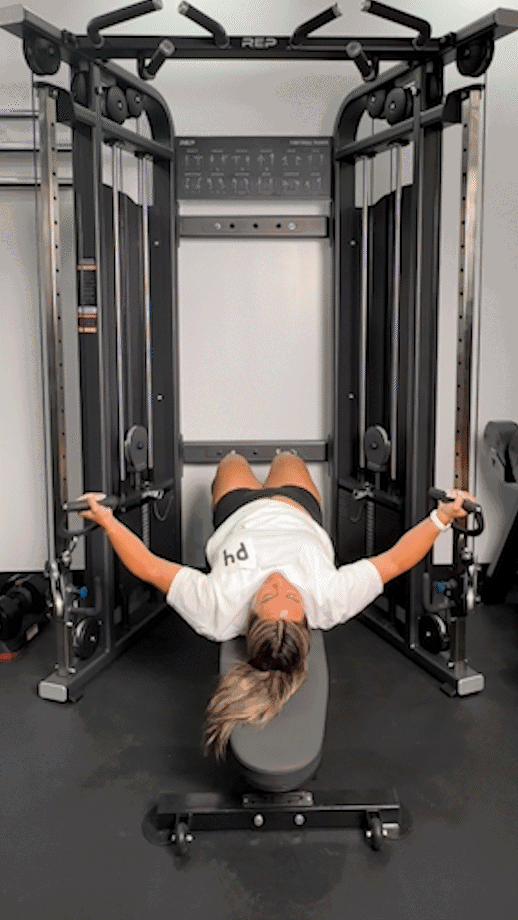
Push-Up Cable Fly
Why Do It: I’m a big fan of bodyweight exercises such as the push-up, and with this exercise, you get the benefits of push-ups and the benefits of the cable fly in one. You’ll work the majority of muscles in your upper body, but especially the chest, triceps, delts, and core.
RELATED: What Muscles Do Push-Ups Work?
How to Do It:
- Adjust both pulleys so that they’re at the top and attach handles.
- Hold the handles with an overhand grip and get into the plank position (you’ll need to put your hands in fists so that you can support your body).
- Breathe in to engage your core, then lower down until your chest is close to the floor.
- Hold, then push yourself up as you would do with a regular push-up.
- When you’re back in the plank position, slowly bring one arm to the side until you feel a stretch in your chest and deltoids. This is the fly component of the exercise.
- Bring the arm back down, then do another push-up. This time, move the opposite arm to the side.
- Keep going for reps, alternating between your left and right arm.
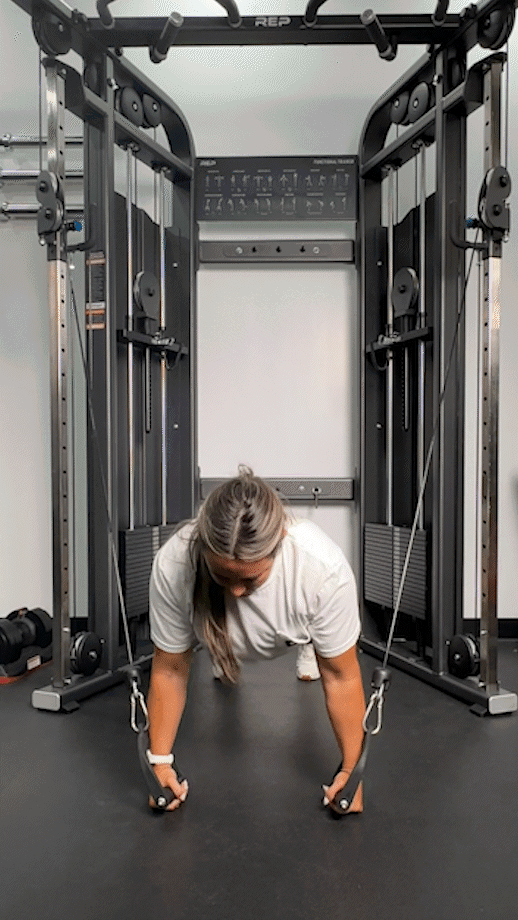
Beginner Cable Chest Workout
OK, so now it’s time for the main event. You know how to do the best cable chest exercises, but how exactly do you turn these into a workout?
My beginner cable chest workout contains cables only. There are four movements to learn but you’ll work different parts of your chest, as well as alternate between standing and using a bench:
- Standing cable chest press: 4 sets of 10 reps
- Cable incline bench press: 4 sets of 10 reps
- Cable fly: 3 sets of 12 reps
- Cable straight-arm pullover: 3 sets of 12 reps
Rest for 60 seconds between each set.
Intermediate Cable Chest Workout
For my intermediate cable chest workout, I’m going to crank up the total volume of sets and also add more exercises. The whole workout will still use cables only but will use a bodyweight exercise as well as single-arm movements:
- Cable bench press: 4 sets of 10 reps
- Push-up cable fly: 4 sets of 8 reps
- Low cable fly: 3 sets of 10 reps
- Cable shoulder rotation: 3 sets of 10 reps
- Decline cable fly: 3 sets of 12 reps
- Cable incline bench press: 3 sets of 12 reps
Rest for 60 seconds between each set.
Advanced Cable Chest Workout
The advanced cable chest workout is for those who want to continue training with barbells, dumbbells, and their own body weight, but want to add more cable chest exercises to their workout routine:
- Flat barbell bench press: 4 sets of 6 reps
- Incline dumbbell chest press: 4 sets of 8 reps
- Push-up cable fly: 3 sets of 10 reps
- Dips: 3 sets of 10 reps
- Decline cable fly: 3 sets of 12 reps
- Cable straight-arm pullover: 3 sets of 12 reps
Rest for 60 to 180 seconds between each set (you’ll likely need more rest for the free weights exercises and less rest for the cable exercises).
Cable Chest Workout: Final Thoughts
There are many reasons why you may consider incorporating a cable chest workout into your training. The cables are safe and versatile, and you can easily adjust the exercise to allow you to target the chest in a different way. If you’re unsure, give my beginner, intermediate, or advanced cable chest workouts a try.
- Focus on the mind-muscle connection. With cable chest exercises, focusing on contracting the target muscle during training can enhance muscle hypertrophy3. Keep this in mind before you increase the resistance and lose the mind-muscle connection.
- Add a light dumbbell for a lower increment. It can be difficult to move up to the next weight level on a cable machine with some exercises. Instead, place a 1- or 2-pound dumbbell on top of the weight stack for a lower increment in order to progress.
- Test, test, test. We’re all different and there will be exercises we’ll like and exercises we’ll hate. Try out all of the above cable chest exercises and choose the few that you love to do time and time again (and then, keep doing them!).
Cable Chest Workout: Q&A
Are cable chest workouts effective?
Training your pectorals with cables can be extremely effective. Cable machines are safer, more versatile, and can provide increased muscle activation of your chest compared to free weights. Some may want to continue bodybuilding exercises such as bench presses and dumbbell presses and add more cable chest exercises to their workout program, but others may prefer to train their chest with cables only. The choice is yours.
How do you work out your chest on a cable machine?
If you’re looking to work out your chest on a cable machine, try adding some or all of the following exercises to your workout routine: standing cable chest press, cable crossover, cable bench press, cable incline bench press, cable fly, low cable fly, single-arm cable crossover, cable straight-arm pullovers, seated cable fly, cable shoulder rotation, decline cable fly, and push-up cable fly.
Aim for between eight and 12 repetitions on each exercise to benefit from hypertrophy, and experiment with different exercises to see what works best.
Which cable fly is best for chest?
There are a number of cable fly exercises that you can do for the chest. These include cable crossover, regular cable fly, low cable fly, high cable fly, seated cable fly, decline cable fly, push-up cable fly, and more. All of these work similar muscle groups to the dumbbell fly. From my experience, I don’t believe there is a single best cable fly exercise and my advice would be to try all of these to see what you like the most. Personally, I do the regular and low cable fly the most often but that’s mainly because it can be hard to find a bench that’s free in the gym I go to.
References
- Schwanbeck SR, Cornish SM, Barss T, Chilibeck PD. Effects of Training With Free Weights Versus Machines on Muscle Mass, Strength, Free Testosterone, and Free Cortisol Levels. J Strength Cond Res. 2020 Jul;34(7):1851-1859. doi: 10.1519/JSC.0000000000003349. PMID: 32358310.
- Signorile, Joseph F.1,2; Rendos, Nicole K.1; Heredia Vargas, Hector H.1; Alipio, Taislaine C.1; Regis, Rebecca C.1; Eltoukhy, Moataz M.1; Nargund, Renu S.1; Romero, Matthew A.1. Differences in Muscle Activation and Kinematics Between Cable-Based and Selectorized Weight Training. Journal of Strength and Conditioning Research 31(2):p 313-322, February 2017. | DOI: 10.1519/JSC.0000000000001493
- Schoenfeld BJ, Vigotsky A, Contreras B, Golden S, Alto A, Larson R, Winkelman N, Paoli A. Differential effects of attentional focus strategies during long-term resistance training. Eur J Sport Sci. 2018 Jun;18(5):705-712. doi: 10.1080/17461391.2018.1447020. Epub 2018 Mar 13. PMID: 29533715.


